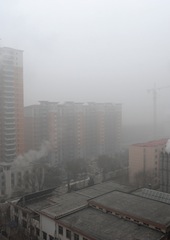Rethinking China’s Future Path
The Chinese economy in its current form may not be sustainable.
March 10, 2014

Economic commentators around the world are sounding alarms with increasing frequency about the outlook for the Chinese economy. Looking beyond these economic bellwethers, however, one finds a simple reality: The Chinese economy in its current form may not be unsustainable.
China’s problems are fundamental. The very factors that have led to the country’s dynamic growth over the past two decades may well constitute China’s chief challenge in the future. Why? Because these sources of growth cannot be sustained.
To be sure, different economic models may forecast a range of possibilities for China. When one views China’s problems through the prism of sustainability, one gets not only several valuable insights but also a possible way forward for Chinese leadership.
Sustainability is generally defined as embracing three core criteria of performance: environmental, social and governance practices.
Environmental calamity
China’s current environmental practices pose a hazard to its citizens and to the world as a whole. If China continues to put growth ahead of sound environmental practice, it will face significant dislocations at home as well as broad-based antipathy abroad.
According to a recent report published by China’s Ministry of Environmental Protection entitled “Soil Pollution and Physical Health,” approximately one-sixth of China’s agricultural land is contaminated with heavy metals and pesticides.
The integration into China’s food supply of contaminated agricultural products grown on these lands poses a public health threat of immense proportion. This is likely to manifest itself in above normal incidence of birth defects, cancers and neurological disorders.
By the same token, Chinas air ranks among the most polluted in the world. All-enveloping smog conditions that periodically blanket China’s major cities, including Beijing and Shanghai, pose a public health menace, while also diminishing productivity, as commerce periodically grinds to a halt for days on end.
Recently, Premier Li Keqiang called for a “war against pollution.” He said it was “nature’s red-light warning against inefficient and blind development.”
On the global level, China’s carbon footprint now exceeds that of the United States by a wide margin. China now accounts for a staggering 23.5% of global CO2 emissions. That is even in excess of its global population share.
To make matters worse, China’s CO2 emissions continued to rise, even as the United States’ CO2 emissions declined for several years during the economic crisis and slow recovery.
Other factors play a role as well. Consider the impending water crisis. A general undersupply of potable water (7% of global fresh water versus 20% of the population) is exacerbated by rampant ongoing industrial pollution. This demonstrates clearly that China cannot sustain the development path it has taken over the past several decades with respect to the environment.
Social injustice
But the problems of sustainability are not confined to the environment. They extend to the various metrics that in the aggregate form a country’s social profile.
Bribery and corruption have been pervasive in China’s development process. China ranked 80th among 177 countries in Transparency International’s 2013 Corruption Perceptions Index.
With a score of 40 on a scale of 0-100, it ranked lower than Brazil, South Africa, Turkey and Saudi Arabia. One needs to look toward the corrupt economies of the Central Asian “Stans” and Sub-Saharan Africa to find bigger offenders.
Bribery and corruption on the scale of China’s undermines the rule of law and impedes fair competition. It also contributes to instability and human rights abuses among China’s less privileged citizens.
Similarly, labor abuse has also been endemic to China’s development process, although China has recently taken steps to strengthen its labor laws. Investigative reports from organizations such as China Labor chronicle an ongoing tale of hopelessness and misery for millions of Chinese workers.
Shoddy labor practices are not only breeding discontent within the Chinese workforce. They also create significant supply chain risk for companies based in developed markets that manufacture in China.
Companies that might be affected include major names such as Apple, Samsung, Toyota, Siemens and Mattel. This already long list of companies facing supply chain issues continues to grow.
Poor governance practices
Finally, China’s overall governance framework – the third pillar in the ESG sustainability process — ranks among the worst in the world.
On the corporate level, the average corporate governance rating for Chinese companies, according to Thomson Reuters Corporate Responsibility Ratings, is a meager 41.9. This places Chinese companies in the bottom third among the nearly 5,000 companies rated worldwide.
Disclosure by Chinese companies is among the worst of any major economy. Risk controls are at best ad hoc and, in most cases, shaped by convenience. Government meddling and political cronyism are pervasive.
As a result, Chinese companies harbor risks and inconsistencies that are not always visible to the naked eye. Over time they may take a toll on China’s ability to sustain an efficient capital market.
Furthermore, hidden flaws in China’s financial and corporate sectors, which have been obscured by China’s development boom, are likely to surface unexpectedly in a slowdown. Count on many land mines currently buried in the corporate landscape to explode then.
ESG: The solution, not the problem
China’s government is well aware of these problems. And its leadership is well aware that, to sustain its impressive economic growth of the past two decades, it will have to adapt. Although the cost of adapting is uncertain, all indications are that the sums involved will be massive.
Change – radical change – is essential for China to maintain stability and expand its prosperity in the years ahead. China’s leaders have shown great wisdom in steering China through its development phase.
Now, leadership might apply that same wisdom by avoiding the temptation to engage in reactive micromanagement of transient economic issues as a solution to the country’s myriad problems.
Instead, Chinese leadership might find it more effective to focus on the longer-term issue of sustainability by establishing a process for the structural reform of its environmental, social and governance policies.
Takeaways
China will face major dislocations at home and broad-based antipathy abroad, if it ignores the environment for long.
On perceived corruption, China ranked worse than Brazil, South Africa, Turkey and Saudi Arabia in 2013.
China’s government is well aware that, to sustain its impressive economic growth, it will have to adapt.
Managing China's transition from developing to developed will require building a sustainable economy.

